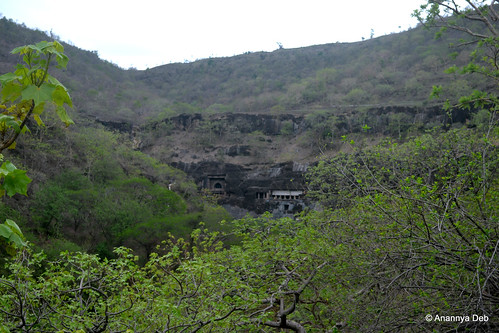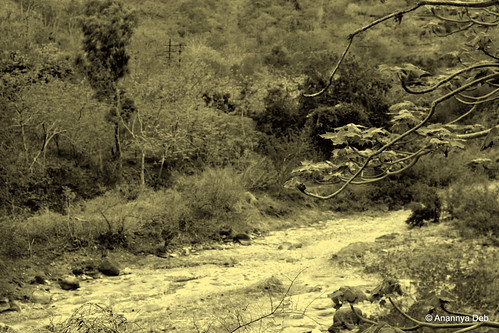The first thing that strikes one is how thoroughly concealed these caves are. You can only see it once you are in the complex. No one, even a kilometre away, would have a clue that something like this exists. On three sides, it is hemmed in by hills. And from the north side, you only see the back of the hill. One can’t even see it from the MTDC facilities at the entrance. You climb up the stairs, turn round the curve of the hill and there in front of you, they stare back at you. It is not difficult to reach. But you will never know where is it.
 The first sighting of the caves, if you follow the present day access road
The first sighting of the caves, if you follow the present day access road
Every one knows the terrain and the shape and the contours and other topographic details of the caves.As the Waghor river snakes through the hills making one hairpin bend after another (or horseshoe bend), you have pairs of basalt hills side by side separated by the river. On one particular bend, the caves are cut on the southern face of a hill on the north bank. If you come from the north, you can’t see it. The hill on the south bank completely hides it from view if you are on the highway in the south. There are no access points from east or west as you have hills interlocking and creating a natural curtain of sorts.
 Following the Waghor river from the north east side towards the caves
Following the Waghor river from the north east side towards the caves
My immediate thought was that these caves were designed for absolute seclusion. Almost all the other cave monasteries that I have been to can be seen from the plains below. Travelers on the road below can sight them easily and work their way towards them for shelter and or enlightenment. Not so for Ajanta.
A similar concept can be seen in forts where the gates are hidden from view. But the difference is that the fort builders have to design and build their fort walls in a way such that the gates are hidden. In the case of the caves of Ajanta, the effect of concealment is a natural feature.
After pondering all this, my next thought was why and how did the first batch of monks choose this location. Were they being persecuted and needed to hide? Were they working on something that was very sensitive and needed to be done in a place where there was no prying eyes. Kanheri and similar caves provided seclusion but they were very much open to public view. Who selected this location? Did that person have a similar accidental discovery as the Englishman who found it in the early part of the 19th century? There must have been something in the Buddhist pioneer’s mind which led him to pick this very specific horseshoe bend of the river. One will never know and therefore one can only imagine many possible scenarios, one as crazy and wild as the other.
 Cave 9, a chaitya hall excavated circa 1st century BCE, part of the initial set of caves
Cave 9, a chaitya hall excavated circa 1st century BCE, part of the initial set of caves
Once one cave was excavated, circa 2nd century BCE, and populated by a few monks, the other caves started coming up. This went on for hundreds of years till about the 1st century CE. Walter Spink, one of the leading researchers on Ajanta, is of the view that the caves were abandoned from the 2ndt century CE till the 5th century CE. After that, for about a hundred odd years, kings, noblemen and commoners donated to the excavation and artistic development of the site which was now inhabited by a new generation of monks. Which means that the place was well known in most parts of the country in those times and Buddhist monks consciously chose that secluded spot for their monastery. Here again there are some thoughts that get triggered as you see each cave.
Monks would most probably be drawn to this complex because the incumbent people must have been some kind of masters and leaders in their field of thought. Almost every cave which served as a dormitory had at least three discussion spaces – a large pillared hall inside, a verandah and an open courtyard by the river. Spending time with these monks must have been extremely fruitful for students of Buddhism – both young initiates into the monastic order and visitors who cut across royalty and commoner. This is validated with the inscriptions found everywhere. It is also validated by various travelogues of those times including Huein Tsang.
The level of artistic brilliance on display is at a level far superior to what we see today. Let’s assume that craftsmen of those times produced extraordinary work for even the most mundane commissions. But this is not a mundane commission. This is an ultra secluded Buddhist sanctuary, one of thousands in the country, virtually invisible even to villagers in nearby areas and the craftsmen produce work which is, as per all the such caves which have been studied, one of the best there is. Surely they were briefed that these caves were special. So what was so special that was happening in this cave, first between the 2nd century BCE to 1st century CE and then again in the 5th century CE?
 Cave 29, one of the last caves to be done, outdoes all the others in terms of the sculptures
Cave 29, one of the last caves to be done, outdoes all the others in terms of the sculptures
And why did it disappear from all consciousness? Coming back to Kanheri, there are inscriptions of 11th century CE of Parsees visiting the caves and meeting the Buddhist inmates there. Which means for at least 600 years after the last known inscription in Ajanta, Kanheri continued to function. But Ajanta seemed to have gone into a decline earlier than the others.
Walter Spink puts it to the decline of Buddhism and the rise of Hinduism as the state religion of most monarchs in the Deccan Peninsula. This loss of royal patronage could be one of the reasons. Possibly, the secret location turned out to its own nemesis as the monasteries remained out of sight and out of mind for most people, especially the various new empires, like the Rashtrakuta (which sponsored the Ellora Caves and some of the Elephanta cave temples), Chalukyas, etc. many of whom might still have supported them as they were known to be secular.
So who were these Buddhist masters who needed such an extreme level of seclusion? Did they achieve their goals which they had set for themselves? And who were the craftsmen who created all these works which would lie hidden in the jungles for over 1400 years?


























